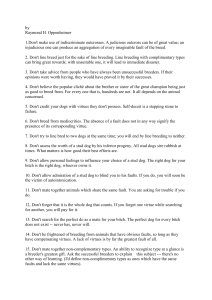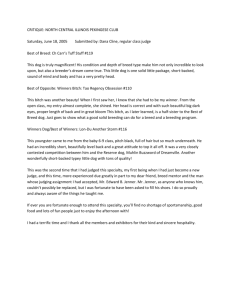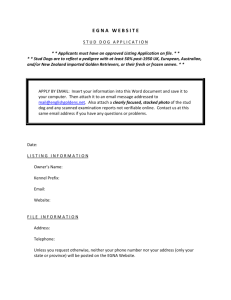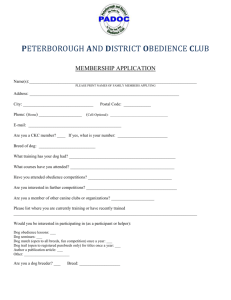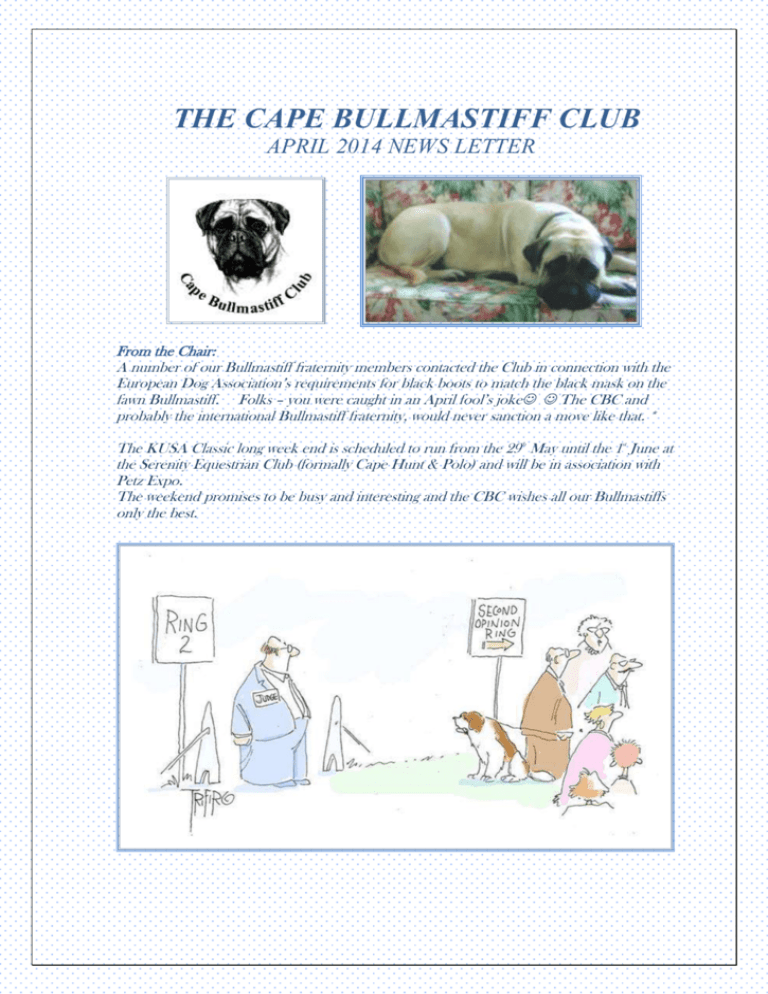
THE CAPE BULLMASTIFF CLUB
APRIL 2014 NEWS LETTER
From the Chair:
A number of our Bullmastiff fraternity members contacted the Club in connection with the
European Dog Association’s requirements for black boots to match the black mask on the
fawn Bullmastiff. Folks – you were caught in an April fool’s joke The CBC and
probably the international Bullmastiff fraternity, would never sanction a move like that. *
The KUSA Classic long week end is scheduled to run from the 29th May until the 1st June at
the Serenity Equestrian Club (formally Cape Hunt & Polo) and will be in association with
Petz Expo.
The weekend promises to be busy and interesting and the CBC wishes all our Bullmastiffs
only the best.
The FCI Shows
Points to be kept in mind when the Judge is assessing your dog in the Breed Show ring:
S/he is looking, primarily, at five categories – Type / Balance / Soundness/ Temperament
and Condition.
Below are the FCI (Federation Cynologigue Internationale) criteria for grading.
Excellent:
Very good:
Close to the ideal
Typical for the breed, well balanced & in good
condition with a few minor faults, but none that
affect the soundness of the dog
Main features of breed but shows faults that detract
from type or soundness
Recognize breed but some serious faults that
detract from type or soundness
Good:
Sufficient:
The Bullmastiff is entered into Group 2 under Molossoids
FCI SHOW DATES:
NTKC Show Friday 16th May (CACIB)
KUSA Show Sunday 1 June (CACIB)
TKC Show Friday 10th October CACIB)
BRVKC Show 21 / 22 October (CACIB) (to be confirmed)
The Stud Dog: (Article Robertson - All rights reserved)
The stud dog’s role in any breeding programme is of vital importance and is too
often ignored with sad consequences for the breed. The stud dog should always be an
exceptional specimen in every way and should be handled and managed accordingly from
the first moment that his potential becomes obvious.
This management would not only include monitoring his health and fitness and show
career, but would also include investigation into any known hereditary diseases within the
breed. As far as the Bullmastiff is concerned hip and elbow dysplasia and eye disorder
clearances are essential, and I recommend temperament testing as well. These tests should
be done prior to any stud duties. If any of these components are found to be undesirable
then the owners of bitches scheduled for potential matings should be given the option to
decide if they want to incorporate such faults into their lines.
If the owner of the stud dog is unable to supply documentary proof of such testing, but is
highly vocal about the qualities of his/her top stud dog, as has happened here in South
Africa, then again the owners of the bitches will have to decide if they trust the stud dog
owner or not. It must be remembered that whatever decision is made, the responsibility is
lifelong and it will affect the well being of the breed.
The majority of responsible breeders in South Africa are now having their dogs xrayed and graded for hip and elbow dysplasia. Very few are concentrating on the eyes,
and even fewer are testing for temperament.
Breeders are advised to take their time to evaluate a stud dog, as indeed the stud
owner should also do to their bitch, and to base their subsequent actions on concrete facts
as opposed to just rushing off to the cheapest easiest option. This is what is referred to in
dog circles as a random mating, and for all that it is worth to the breed, could just as well
be the dog on the street corner.
The first mating
Prior to the stud dog’s first mating and as part of his upbringing, there should have
been exposure to “the birds and the bees of dogdom”. A dog maintained in isolation for
his formative months or years and then presented to a bitch for mating may well have no
idea what to do.
Assuming that this is not the case and the dog is quite willing and able to perform
the task required of him, then the owner of the sire and dam should have come to an
arrangement prior to the occasion as to what the required conditions for the mating are
and to the amount of stud fee payable.
Normally the bitch is brought to the dog that can be utilized, from approximately
eighteen months of age for a first mating. Thereafter it is advisable to allow the dog to
mature, after which he can be used on a regular basis providing he is maintained correctly.
Veteran studs can also be used providing they have received a sperm analysis clearance
test. This would indicate their fertility level that does start to decline with age.
For an unproven stud the first fee is sometimes waived or reduced or requested
only if offspring are produced. Thereafter a set arranged fee could be asked. In South
Africa at present the current trend is the price of a puppy providing the litter is substantial.
A point to remember is that the payment of a stud fee is actually for the services rendered
by the stud dog and should not refer to conception or the amount of puppies whelped.
However the arrangement can vary between the conventional and the unconventional just
so long as the two parties agree. If there is any uncertainty, then a written contract is the
best arrangement.
It is the male that determines the sex of the offspring and his sperm can live in a
healthy vaginal tract for approximately five to six days. The bitch determines the number
of puppies conceived by the number of eggs produced and subsequently fertilised. Both
parents contribute 39 chromosomes each which contain the genes which determine the
outcome in respect of coat and eye colour, personality traits, shape, size and so on. These
78 chromosomes are what are referred to as the genetic blue print of a breed. Some of
these genes are recessive and some are dominant.
The ideal stud register
Way back in the late 1940’s, the Germans began the concept of the ideal stud
register with the German Shepherd Dog in mind. Their aim was to present a “picture” of
the stud dog. The system was divided into four categories, namely A for Type, B for
Appearance, C for Conformation and D for Temperament. There was an appropriate
scoring system and this was then entered on the dog’s pedigree. At a glance the whole
vision of the dog was there.4
To administer, a monumental task in itself, and to maintain such a register,
absolute honesty and integrity is necessary or the concept will fail before it begins, as
happened with the German effort. But dreams and fantasies are part of our lives and I
dream of a register for Bullmastiffs with the following:
Full registered name of stud dog
Common or call name
Sex
KUSA registration number
Identification tattoo or microchip
Championship status
Qualifications eg: APT HD 0:0 ED 0:0 Eyes clear, CBA
Height
4
Flieg, Dr D. The Technique of breeding better dogs, p 31
Weight
Date of birth
Place of birth eg: Cape Town, South Africa
Coat colour eg: Red / Brindle
Eye colour
Health status/ record including known problem areas eg: Gastropexy 1998
(Indicative of a history of gastric torsion in the line)
Record of temperament &/or testing &/or incidents e.g. CBA / DMA /APT.
Bite eg: level
Any known defects eg: Broken canine
Colour photo from both front and side view
Breeder
Owner
A five-generation recording of antecedents including the sire and dam with all the
above -mentioned items. (This should enable a meaningful evaluation of the dog
and or its line and not just be a string of names with the word Champion
occasionally present in front of a name)
Stud duties performed eg: bitches particulars, number of matings, AI or natural
mating
Number of puppies born/ survived / euthanased and quality of puppies as assessed
by an external body at six weeks of age
Clearance of the offspring eg: if the dam had hip dysplasia and breeding
restrictions were placed on the offspring
Line breed / in breed or outcross.
To conclude on the stud dog, all breeders should take cognisance of the fact that the top
winning dog in the show ring and / or the national stud dog are not necessarily the right
dog for their bitch.
BISS Ch Sondu Casca HD 0:1
South Africa’s first Top Stud Dog
Ch & Int Ch Don Amigo Pasco of
Beautybull HD B1 B2 ED 1:1
South Africa’s present Top Stud Dog
CH FIGOR CYNARA of HAAITA BEATS THE BATTLE OF
THE BULGE
BEFORE 58 kg
HALFWAY 52 kg
47.6 kg ALMOST THERE
GOAL ACHEIVED
NEWS OF OUR LOCAL BULLMASTIFFS - ALL WITH
SPECIAL TALENTS
“Blommie” visiting the Edenhaven Retirement Village where she gave out a lot of licks
and love to the residents and visitors who enjoyed every moment of this very special
occasion.“Blommie” is from the Desoete kennels of Magda & Hans Ledoux
.
“Lizzie” and Richard from Port Elizabeth both enjoy the fun, sun and the sea.
“Lizzie” is owned by the Muller family – or perhaps it is the other way round!
“Saffira” and “Mia” Rogers supported the Cansa Bark for Life event in Worcester
and thoroughly enjoyed the day.
EDMOND BULLMASTIFFS
Lady Shanon
Lord Pablo
Lord Brutus
Lady Verusche
Edmond Bullmastiffs are situated in the Free State and are a small select kennel with
KUSA registered Bullmastiffs
Their contact details are: edmondbullmastiffs@gmail.com and
www.edmondbullmastiffs.wozaonline.co.za or 0820850353
DOG MENTALITY ASSESSMENT AND APTITUDE TESTING:
UPDATE
Class of 2014: APT Judges and Marshalls from the Western Province Rottweiler Club,
Cape Rottweiler Club, Cape Bullmastiff Club and the WP Boxer Club ‘take five’ after
having just completed a practice session prior to the DMA and APT testing in mid May.
Michelle and her Boxer
Nicky and her Bullmastiff
These two ‘practise’ dogs, both seasoned APT combatants are being used to hone the
skills of the Learner Marshalls.
The DMA and APT testing is essentially for working breeds, but can include some
hunting, Herding or Utility Breeds should any fanciers desire it. It tests, amongst other
things, steadiness of character, hunting drive, sociability and the ability to unwind rapidly
after stressful situations. It is KUSA approved as a mental testing method and a non –
mandatory test. The successful dog receives the much coveted title of APT behind his
name.
THE BULLSAINTS BULLMASTIFFS*
The bitch at the rear was the model with the ‘black boots’! This photo was taken just
before she went into the mud – The CBC extends thanks to the Bullsaints Bullmastiffs
At last – the much anticipated Bullmastiff manual has arrived and all members who
ordered and paid for a copy will soon be receiving the book in the post.
Calling all owners of brindles - The May issue of the CBC News letter will
feature the Brindle Bullmastiff and we look forward to receiving your
photo’s - Send them in to the Chair at info@capebullmastiff.co.za.
The information in this magazine is confidential to the members. Statements or opinions
may be expressed in this communication that are personal to the writers and do not
necessarily represent the views of the Club.
The Cape Bullmastiff Club
Post Net Suite 65
Private Bag X15
Somerset West
7129
info@capebullmastiffclub.co.za
www.capebullmastiffclub.co.za
KUSA affiliated #1151 Est. 2011
LOVE IN ABUNDANCE

